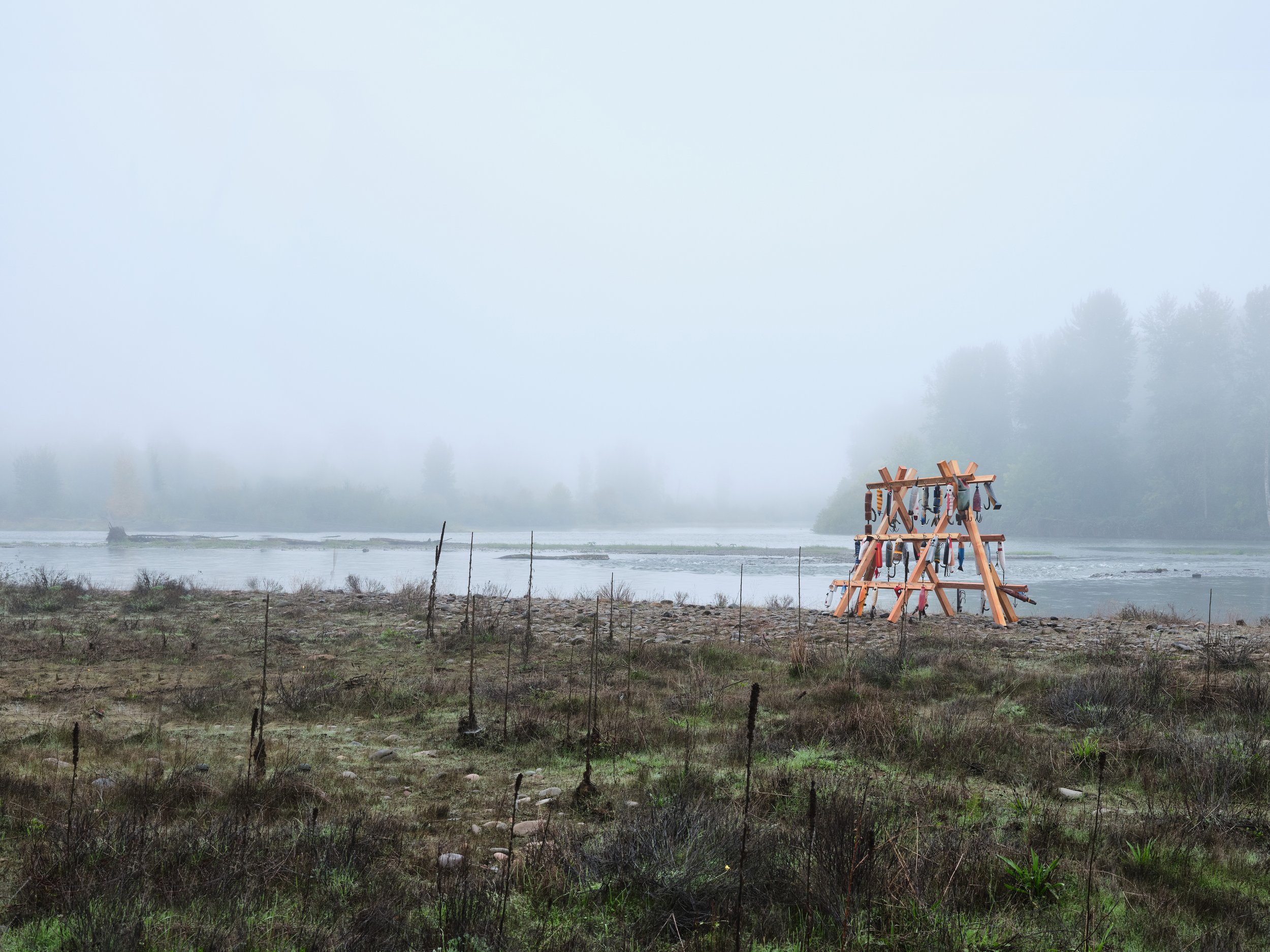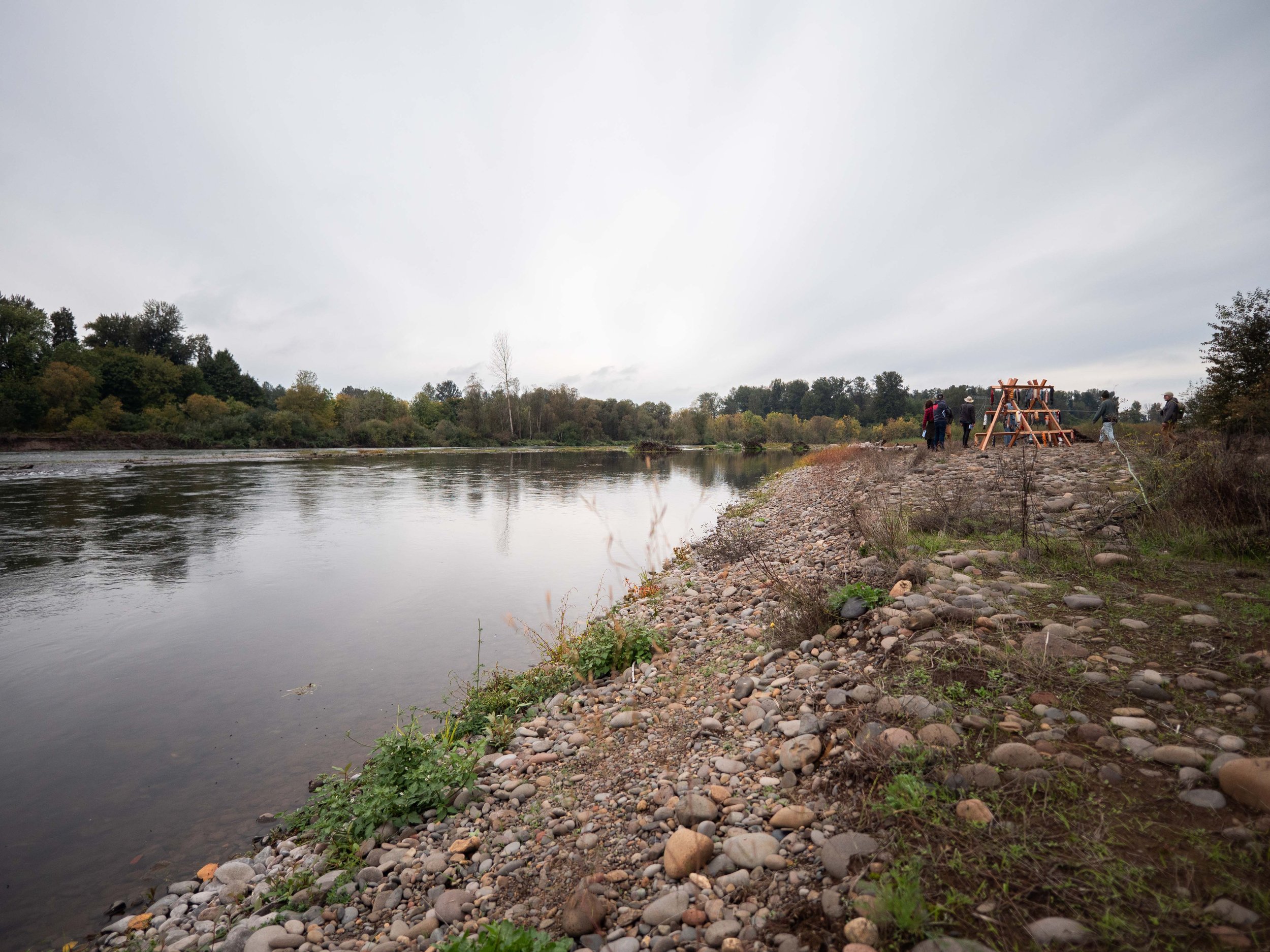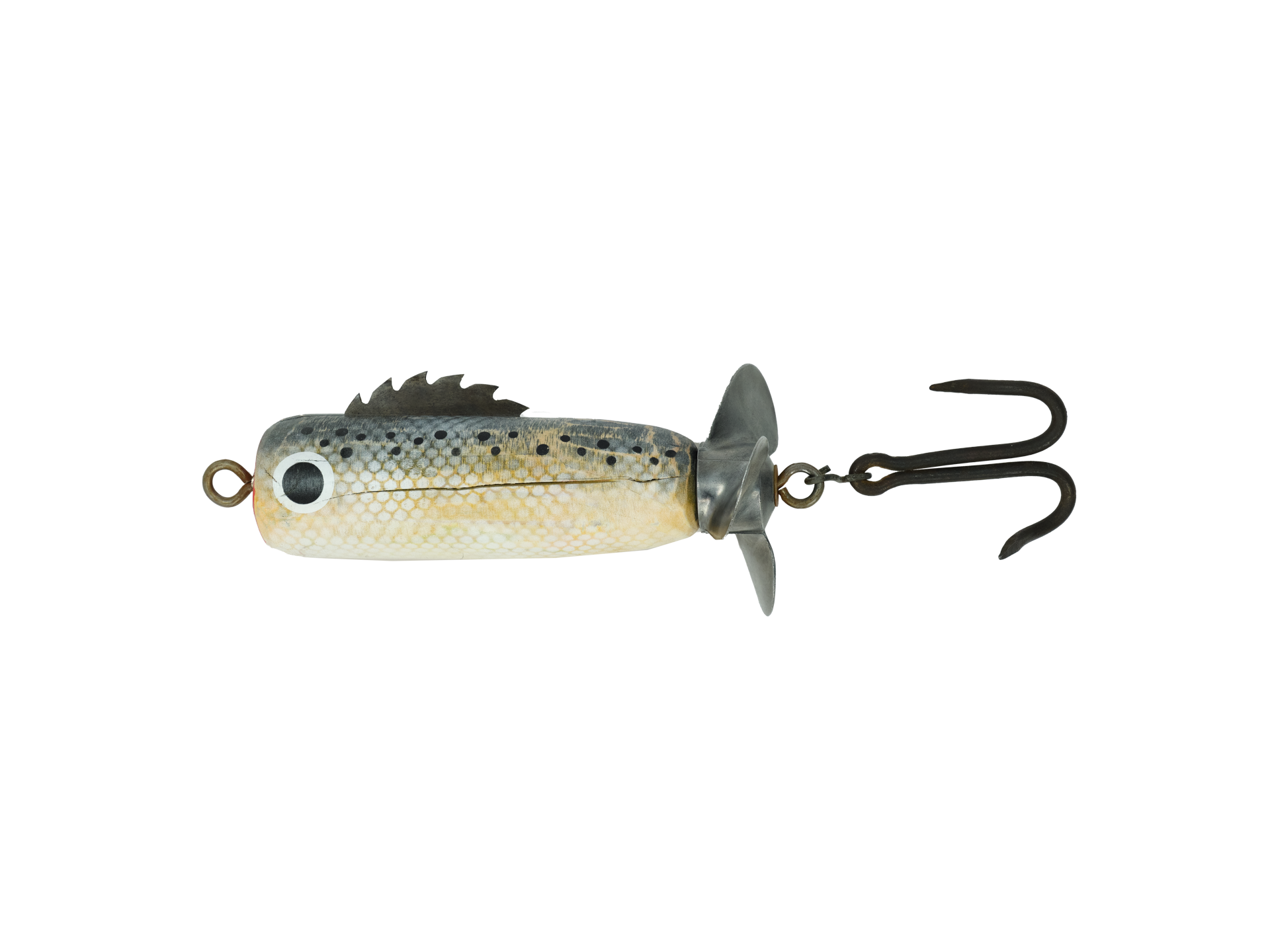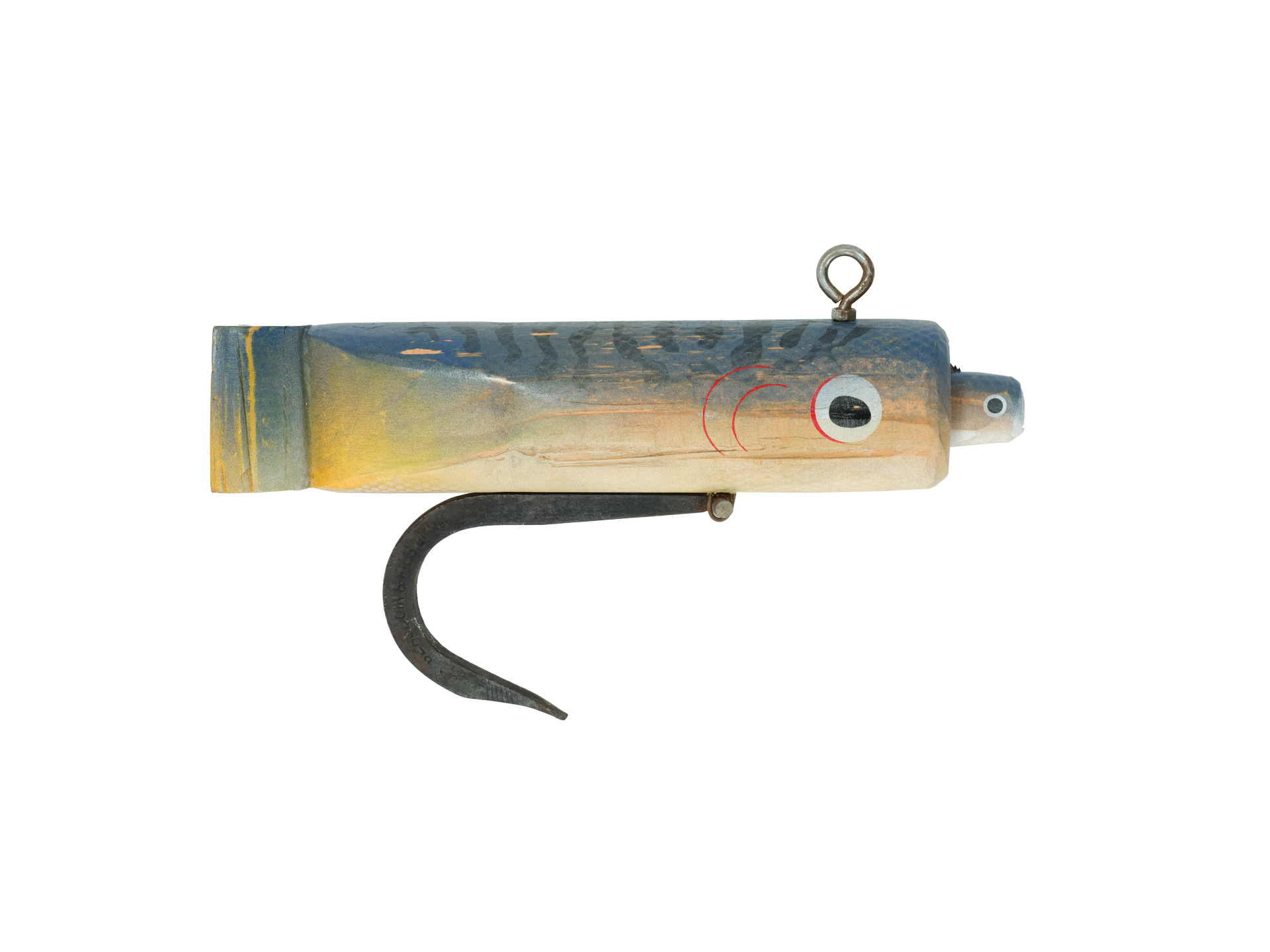
Arboreal Angler Collection
Tying Historic Logging to River Ecology
Exhibition at the Thelma Art Institute, Fon Du Lac, Wisconsin
03/29-05/09/2025
The Arboreal Angler Collection is a creative combination of angling traditions, vernacular timber construction, and vintage logging camp equipment, aimed to capture the critical relationship between the local river ecosystem and the region’s wood. The collection contains a diverse assemblage of oversized lures ranging from 12 to 32 inches. Each lure consists of three primary elements: the wood body, the hardware, and the dressing. When these elements are combined, they tell a rich story about the ecological role of large wood in aquatic ecosystems and their intertwined history with the timber industry. Each piece within the collection represents local organisms that rely on large wood for food, habitat, or the geomorphological processes it facilitates.
The Arboreal Angler Collection has been built in collaboration with:
David Buckley Borden
Adam DeSorbo
Asa DeWitt
Ashley Ferguson
Jenny Ginn
Blake Schouten
Nancy Silvers
Sabine Winkler
This project was proposed as part of Ian’s Masters of Landscape Architecture project at the University of Oregon. It was developed and fabricated throughout the Summer of 2023 with the generous support of the Fuller Design Fellowship team at the Fuller Initiative for Productive Landscapes.
Photos were taken by Adam DeSorbo and Ignacio Lopez Buson
Brook Charmer
The Brook Charmer is a nimble lure, perfectly suited for the swift rapids and cold ripples of Wisconsin’s rivers and streams. Its spinner blade and saw-fin create lifelike movement, bringing it to life in fast-moving waters. For optimal performance, pair it with a fluorocarbon line.
Dam Dillinger
The Dam Dillinger was first crafted to mark the centennial of the DePere Dam. Wisconsin’s first dam, built in 1809, was originally intended to power a sawmill. But dams do more than just generate power—they disrupt water flow and halt the natural transport of wood through aquatic ecosystems.
Tempting Termite
This mysterious lure was found in an old pile of sawdust in the remnants of Wendling Oregon, an old Booth-Kelly company town.
Trusty Tricho
The Trusty Tricho can be used to catch anything from rainbow trout fries to adult sculpin. The Trusty Tricho mirrors the tasty characteristics of the wood-scraping trichoptera.
Daring Dofleini
Are you looking to catch seals, sea otters, sharks? The Daring Dofleini is the lure for such a cast. This lure moves like and appears to be a Giant Pacific Octopus. Use this lure near sunken driftwood, where the Giant Pacific Octopus may be found hunting for prey.
The deadliest lure ever cast. The Magic Hex is said to host an ancient curse. This imitation Mayfly has a reported a 100% success rate, however, those who use it cast their luck with the Swamp Auger, a fearsome critter that resembles a sunken log. The Swamp Auger uses its swivel proboscis to drill 3-inch holes into the bottom of fishers boats. If you use the Magic Hex, bring cayenne pepper and be ready to tickle the snout of a Swamp Auger!
Magic hex
Frilly Fry
The Frilly Fry has been carefully engineered to mimic trout fries, the juvenile form of a trout. For the best success, use the Frilly Fry in tranquil pools created by wood in streams.
Looking for an energizing injection of oxygen and turbulence in a stagnant, eutrophic fishing pool? Look no further than Borden’s Bubble Bomber! Good for use in logged zones with no woody debris to absorb and slow the flow of topsoil and nutrients into pristine forest fishing pools.
Borden’s Bubble Bomber
Dosorbo’s Daily Double
Sturgeon Strike
For best luck, use the Sturgeon Strike in an estuarine habitat with extra sinkers to keep it the deep.
What’s better than catching a fish? Catching a fish and getting paid for it! Dosorbo’s Daily Double is an immaculate imitation of the Northern Pikeminnow, a fish whose populations benefit from the reservoirs and dams built throughout the West Coast. The pikeminnow’s meal of choice is salmon smolts, only adding to the unfavorable conditions for the long-term success of our beloved salmon. The solution? A fish bounty funded by the Bonneville Dam of up to 10$ per pikeminnow.
Scary Planarian
Yikes! A Scary Planarian, if you’re a microscopic organism, you better watch out! This freshwater carnivore can be found clinging to rocks and wood. These worms are great snacks for fries in stream pools.
Remarkable Woodrat
The Remarkable Woodrat is the hottest lure in the riparian corridors. Large hungry trout simply can not resist this delectable treat. This arboreal rodent lives in cavities of trees, snags, and fallen trees and is careful to avoid rivers at all costs!
Enticing Eft is a reproduction of the tasty juvenile eastern newt, a forest floor predator found hunting for grub in decomposing wood. At this stage of its life, eastern newt spends most of its time under the protection of decomposing wood, only resurfacing on warm and rainy nights. It is on these nights that bass may opportunistically feed on these elusive newts.
Enticing Eft
Gyroscopic Grenadier
The Gyroscopic Grenadier is a deep diving plug used to catch krakens and the like. These specimens can be found lurking around sunken wood, feasting on shrimp, crabs, and small fish.
Lucky Lamprey
The Lucky Lamprey has a heavy wedge head which is used by the expert fishers to clear the way for future casts, said to be able to clear the ‘jammedest jam’. Lampreys rely on the geomorphological process that wood in rivers and estuaries facilitate.
Dreaded Dredger
The Dreaded Dredger was found at the bottom of the Mississippi River, stuck between a rock and a hard place.
The Sinking Shipworm is the most feared marine organism of the wooden boat community. The aggressive shipworms eagerly bore into wood, promoting decomposition of driftwood, and sinking ships at sea.
Sinking Shipworm
Coaxing Caddy
The Coaxing Caddy is a favorite for growing salmon fry which need to be coaxed out from protective hiding places made by large wood. Use this lure in the deep pools made by jammed wood in streams.
Feathers, kinetic parts, hooks and sinkers, this Amphipod lure has it all. This heavy-weight champion needs to go deep down to the bottom of the sea where sunken wood provides food for Hirondellea gigas, a wood eating amphipod. These amphipods can catch a diverse range of deep sea predators.
Arboreal Anglers Continued
All-In-One Amphipod
Whistle Punk Pete
Everyone knows the plight of Old Whistle Punk Pete, who, despite his small stature, dreamed of being a hooktender. What is less known is that Whistle Punk Pete realized he had become a hooktender after all as he was hooking and fishing, and then gotta thinking. It was with this lure that he stated, “Holy cow-wow, if the crew could see me now, I am a hooktender after all.”
Dewitt’s Dancing Diver
Dewitt’s Dancing Diver was made with exquisite craftsmanship. This lure has three segments to create lifelike movement. The layers of paint add beautiful patterns of scales and color. Dressed with dressing that a seasoned angler wishes they could finesse. Well done.
The Chrinomidae Charmer is the closest thing to a perfect representation of the unassuming non-biting midge that shreds wood and organic matter in rivers. The non-biting midge is a favorite catch for trout hiding under downed trees and submerged wood.
Chrinomidae Charmer
Notta Sucker
Need something to blame whilst you’re down on your luck? The large-scale sucker has been unfairly accused for attributing to the low trout and salmon stock by PNW anglers, creating consequences for these poor suckers!
Grib-L-Grab
The Grib-L-Grab is sure to convince any estuary-inhabiter that a wood boring Gribble has let down its guard. The Gribble is a tasty wood boring isopod who plays a pivotal role in the mechanical decay of driftwood.
Powder Polywog
From the 1850’s-1930’s lumber companies practiced “stream improvements” which often used dynamite to clear river obstructions such as log jams and boulders. The workers responsible for the dynamite were called “Powder Monkeys.” Aquatic habitats were obliterated by these practices.
Haywire Herring
The Haywire Herring will trick even the most sharp predator into thinking they have a live Herring in their sights. For best results, use the Haywire Herring in protected estuaries with hanging weights.
Redside Wobbly
The Redside Wobbly is named after its favorite user, the Wobblies, an endearing nickname for the timber workers in the International Workers of the World. This lure catches fish with ease, so after those hard-working days, and all that union busting, the workers knew they could rely on this lure for a consistent catch.
Bristled Baiter
The Bristled Baiter should be used in the depths of the ocean where Bristle Worms bore into sunken wood.
Skullduggering Skipjack
Commercial fishers, looking for tasty skipjack tuna, know to cast their nets under adrift wood in the ocean.
Cascade Croaker
The cascade frog usually hides from predators using wood, so when a fish sees the Cascade Croaker, it is unable to resist this delectable delicacy. Anglers are encouraged to use this lure as a substitute for the real cascade frog, an amphibian that is currently under review to be listed in the Endangered Species Act.
Sea Salad
Need to catch a vegetarian sea critter? The Sea Salad’s impeccable patterns, gyroscopic weight, and frilly feathers closely resemble seaweed or algae anchored on adrift wood.
Shameless Shad
This lure is one of the largest lures in the collection, and it’s proud of it. The Shad was introduced in 1871, and it gladly took over the large rivers of the PNW in the millions.
Hungry Humdinger
Small fry better watch out! Deep in the pools made by wood obstructing water flow lurks much larger and hungry fish. There is always a bigger one waiting for the next bite!
O’boy Orca
The O’Boy Orca was found on the wall of an old logging bar just north of Coos Bay. Orcas are apex predators; nothing would dare eat them. These ‘wolves of the sea’ primarily eat Chinook Salmon and krill, all of which follow floating driftwood for food.
Dancing Gandy
The Dancing Gandy is a one-of-a-kind lure. As the transcontinental railway finally reached Oregon in 1880, logging railroads quickly spread throughout the old-growth forests. Rail allowed entire camps of loggers to travel to previously isolated areas. Originally produced with two shiny black eyes, Dancing Gandy had a rail spike driven through it in the form of an environmental protest.
Mack-A-Tack
The Mack-A-Tack is of the sea and krill variety. This irresistible lure is best used near floating driftwood where Mackerel are known for using the shadows of the wood to catch plankton. This lure is best for catching tuna, a predatory fish known to lurk around wood adrift at sea.
Deep Diving Angler
The Redside Wobbly is named after its favorite user, the Wobblies, an endearing nickname for the timber workers in the International Workers of the World. This lure catches fish with ease, so after those hard-working days, and all that union busting, the workers knew they could rely on this lure for a consistent catch.
Captain Coho is an underutilized lure considering that the salmon is the most beloved fish of the PNW. Just be careful, Oregonians love to eat their salmon too! Keep this lure away from hungry onlookers.
Captain Coho
Tails from the Tackle Box:
Lures, much like industrial logging in America, are largely a Euro-American introduction. Fishing flies have long been tied in Europe since the mid-15th century, but plugs, spinners, and jigs are a recent modern American technology. The first wooden lure, a wooden plug, was invented by James Heddon in Dowagiac, Michigan around 1889. This wooden lure was a pine broomstick that was carved to resemble the body of a frog.
As soon as the wooden lure was cast in the local Mill Pond, a bass instantly demolished it. Heddon immediately decided to capitalize on this improvement in fish bait. Prior baits were made of sheet metal, wire, and feathers and didn’t have any signs of life as they moved through the water. The wooden lures wobbled and swam, entrancing the hungry bass.
Following the Heddon Frog, James developed and patented the 1902 Dowagiac Minnow and the 1907 Artistic Minnow 50. These three lures quickly established a range of forms, features, and functions that continued to entice fish.
Today, it is easy to think that lures have always been manufactured and sold, but this wasn’t the case. For most of the history of lures, they were homemade and shared amongst friends. This led to an explosion of creative and unique lures of all shapes and sizes. Experiments like coating plugs in photographic negatives, adding spoons, or making lures out of stone have led to exciting and diverse collections. Although these folk lures are rich and imaginative, they may not have precise dates or locations in which they were made.
Angler collectors rely on lure patents to identify and certify vintage and antique lures. The patents were used by industrious lure manufacturers to privatize their lure design even before they knew whether or not it would work. The documentation of these lures have created a strong relationship between vintage lures and patents which can be seen in collector’s books.






















































